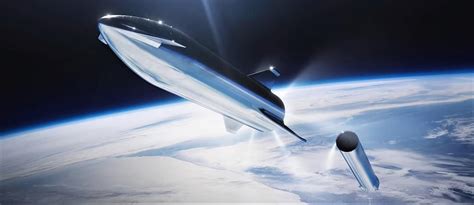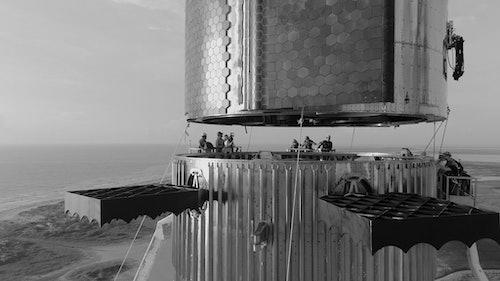
SpaceX’s Starship May Finally Circle Earth On a Critical Test Flight
Story by Molly Glick
Later this month, the much-delayed moment that space fanatics have breathlessly anticipated may finally arrive: the Starship orbital launch test flight. The world’s most powerful rocket, which can fire up to around 17 million pounds of thrust at liftoff, will briefly take a lap around the Earth. This test could break history: If it all works out, Starship could become the world’s most powerful operational rocket.

SpaceX’s Starship May Finally Circle Earth On a Critical Test Flight
It isn’t yet clear what time the orbital flight will take off from SpaceX’s Starbase facility in Boca Chica, Texas. But Elon Musk tweeted on April 10 that the Starship launch is “trending towards near the end of third week of April.” This past weekend, SpaceX engineers deemed the Super Heavy and Starship launch system ready for launch, Ars Technica reported.
This news comes just over a week after SpaceX appeared to move the second-stage prototype Ship 24 to the Starbase orbital launch pad. On April 3, journalists spotted the company running fuel tests with the first-stage prototype, Booster 7.

If Starship passes the crucial test with flying colors, SpaceX has high hopes for the massive rocket. Musk’s company hopes the rocket can deliver its Starlink internet satellites to space — and even whisk people to the Moon and Mars. As part of a $2.89 billion contract with NASA, Starship will carry humans to the Moon during its upcoming Artemis missions in 2025 and beyond.
But SpaceX is still a ways away from these cosmic dreams. First of all, the company hasn’t yet received a launch license from the FAA that’s legally required for liftoff. And Starship must be proven safe before a crew can even step inside — spaceflight can quickly turn fatal, Erik Seedhouse, an associate professor in spaceflight operations at Embry-Riddle Aeronautical University in Florida, tells Inverse.
“It’s supremely risky, and there’s so, so many things that can go wrong,” he says. “Especially with something like [Starship] where it’s so big, and they’re really pushing the envelope in terms of what can be done.”
What is an orbital test?

This test will help SpaceX determine whether Ship 24 can safely circle the Earth and plop into the sea.
Nearly three minutes into the flight, Booster 7 will drop into the Gulf of Mexico. Ship 24 will continue on, traveling around the planet before plopping into the Pacific Ocean off the coast of the Hawaiian island Kauai.

InverseFollow
SpaceX’s Starship May Finally Circle Earth On a Critical Test Flight
Story by Molly Glick • 5h ago
Later this month, the much-delayed moment that space fanatics have breathlessly anticipated may finally arrive: the Starship orbital launch test flight. The world’s most powerful rocket, which can fire up to around 17 million pounds of thrust at liftoff, will briefly take a lap around the Earth. This test could break history: If it all works out, Starship could become the world’s most powerful operational rocket.
SpaceX’s Starship May Finally Circle Earth On a Critical Test Flight© Provided by Inverse
It isn’t yet clear what time the orbital flight will take off from SpaceX’s Starbase facility in Boca Chica, Texas. But Elon Musk tweeted on April 10 that the Starship launch is “trending towards near the end of third week of April.” This past weekend, SpaceX engineers deemed the Super Heavy and Starship launch system ready for launch, Ars Technica reported.
This news comes just over a week after SpaceX appeared to move the second-stage prototype Ship 24 to the Starbase orbital launch pad. On April 3, journalists spotted the company running fuel tests with the first-stage prototype, Booster 7.
SpaceX’s Starship May Finally Circle Earth On a Critical Test Flight© Provided by Inverse
If Starship passes the crucial test with flying colors, SpaceX has high hopes for the massive rocket. Musk’s company hopes the rocket can deliver its Starlink internet satellites to space — and even whisk people to the Moon and Mars. As part of a $2.89 billion contract with NASA, Starship will carry humans to the Moon during its upcoming Artemis missions in 2025 and beyond.
Up To $95 Off Your First Year – McAfee® Official Site
www.mcafee.com/Official-Site/TotalProtection
But SpaceX is still a ways away from these cosmic dreams. First of all, the company hasn’t yet received a launch license from the FAA that’s legally required for liftoff. And Starship must be proven safe before a crew can even step inside — spaceflight can quickly turn fatal, Erik Seedhouse, an associate professor in spaceflight operations at Embry-Riddle Aeronautical University in Florida, tells Inverse.
“It’s supremely risky, and there’s so, so many things that can go wrong,” he says. “Especially with something like [Starship] where it’s so big, and they’re really pushing the envelope in terms of what can be done.”
What is an orbital test?
SpaceX’s Starship May Finally Circle Earth On a Critical Test Flight© Provided by Inverse
This test will help SpaceX determine whether Ship 24 can safely circle the Earth and plop into the sea.
Nearly three minutes into the flight, Booster 7 will drop into the Gulf of Mexico. Ship 24 will continue on, traveling around the planet before plopping into the Pacific Ocean off the coast of the Hawaiian island Kauai.
All in all, the whole shebang should only take about 90 minutes, according to a SpaceX document submitted to the Federal Communications Commission. That’s a lot shorter than recent orbital flights, including NASA’s uncrewed Boeing Starliner test in May 2022, which spanned six days and included a pit stop at the International Space Station.
Elon Musk gave Ship 24 about a 50 percent chance of completing the orbit during the first test, but SpaceX is currently constructing multiple Starship prototypes and aims to run a series of trials — this should give the company around 80 percent odds of reaching orbit in 2023, Musk said in an interview last month.
Starship last took to the skies in May 2021. SN15, a three-engine upper-stage prototype, traveled up just over 6 miles and dropped back to Earth.
Since then, SpaceX has run through various tests, including firing up 31 of its 33 Raptor engines last February. Before the big day, the company also needs a launch license from the Federal Aviation Administration, which has asked the company to jump through various hoops in preparation.
Even if SpaceX receives the license soon, the company could face lawsuits over potential environmental concerns — further delaying the much-anticipated test. Boca Chica locals have already criticized Musk’s company for littering the area with rocket debris and threatening wildlife.
What could go wrong with the Starship orbital test?

Rockets come with a dizzying array of complex components, so SpaceX will watch closely during the orbital test to see if anything malfunctions.
SpaceX successfully fired 31 of its engines in a static fire test on Feb. 9, but the team failed to get two of them to ignite. While the plan was to light all 33, the “team turned off 1 engine just before start & 1 stopped itself, so 31 engines fired overall,” Elon Musk tweeted. “But still enough engines to reach orbit!”
If the rocket manages to lift off unscathed, there’s another issue it could encounter not long into its journey. Around 30 to 60 seconds after launching, rockets accelerate through the atmosphere at tens of thousands of miles per hour and face massive amounts of pressure.
Unfortunately, precise atmospheric conditions can’t be predicted beforehand — which means that the vehicle could face serious risks. “You can do all the computer simulations in the world, but it’s almost impossible to factor in the changing winds as the spacecraft goes higher up in the atmosphere,” Seedhouse says.
What’s next for Starship and SpaceX?

SpaceX ultimately wants Starship to carry up to 100 passengers on trips to Mars to create a “self-sustaining city” on the Red Planet, Musk said in 2019.
In the coming years, though. Starship will stick to Moon travel. In addition to the NASA contract, the massive vehicle will fly billionaires and a group of artists — including DJ Steve Aoki — around the Moon.
SpaceX will also team up with tech entrepreneur and billionaire Jared Isaacman on a series of missions that the company estimates will kick off this coming summer — culminating in the first crewed Starship flight, though the company has shared few details on this trip.
Overall, SpaceX hasn’t offered much information on how Starship will support crews up in the cosmos, according to Seedhouse. He imagines it could look somewhat similar to the tech on the company’s Dragon capsules — but scaled up for a (much) larger vehicle. “In terms of the details, SpaceX tends to keep that very close to the chest,” he says.

Comments (0)